Marco Gavanelli
Logic-Based Benders Decomposition in Answer Set Programming for Chronic Outpatients Scheduling
May 19, 2023Abstract:In Answer Set Programming (ASP), the user can define declaratively a problem and solve it with efficient solvers; practical applications of ASP are countless and several constraint problems have been successfully solved with ASP. On the other hand, solution time usually grows in a superlinear way (often, exponential) with respect to the size of the instance, which is impractical for large instances. A widely used approach is to split the optimization problem into sub-problems that are solved in sequence, some committing to the values assigned by others, and reconstructing a valid assignment for the whole problem by juxtaposing the solutions of the single sub-problems. On the one hand this approach is much faster, due to the superlinear behavior; on the other hand, it does not provide any guarantee of optimality: committing to the assignment of one sub-problem can rule out the optimal solution from the search space. In other research areas, Logic-Based Benders Decomposition (LBBD) proved effective; in LBBD, the problem is decomposed into a Master Problem (MP) and one or several Sub-Problems (SP). The solution of the MP is passed to the SPs, that can possibly fail. In case of failure, a no-good is returned to the MP, that is solved again with the addition of the new constraint. The solution process is iterated until a valid solution is obtained for all the sub-problems or the MP is proven infeasible. The obtained solution is provably optimal under very mild conditions. In this paper, we apply for the first time LBBD to ASP, exploiting an application in health care as case study. Experimental results show the effectiveness of the approach. We believe that the availability of LBBD can further increase the practical applicability of ASP technologies.
Non-ground Abductive Logic Programming with Probabilistic Integrity Constraints
Aug 06, 2021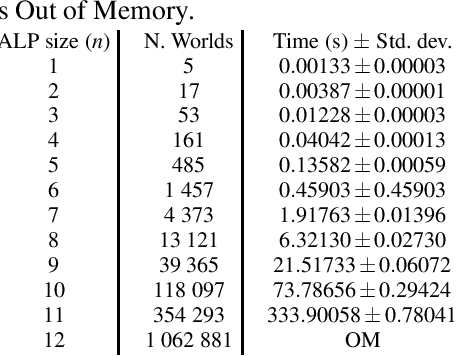
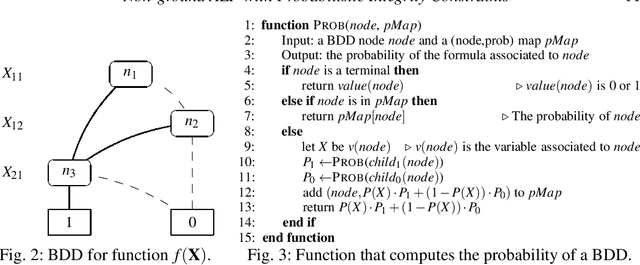
Abstract:Uncertain information is being taken into account in an increasing number of application fields. In the meantime, abduction has been proved a powerful tool for handling hypothetical reasoning and incomplete knowledge. Probabilistic logical models are a suitable framework to handle uncertain information, and in the last decade many probabilistic logical languages have been proposed, as well as inference and learning systems for them. In the realm of Abductive Logic Programming (ALP), a variety of proof procedures have been defined as well. In this paper, we consider a richer logic language, coping with probabilistic abduction with variables. In particular, we consider an ALP program enriched with integrity constraints `a la IFF, possibly annotated with a probability value. We first present the overall abductive language, and its semantics according to the Distribution Semantics. We then introduce a proof procedure, obtained by extending one previously presented, and prove its soundness and completeness.
Logic Programming approaches for routing fault-free and maximally-parallel Wavelength Routed Optical Networks on Chip (Application paper)
Jul 18, 2017

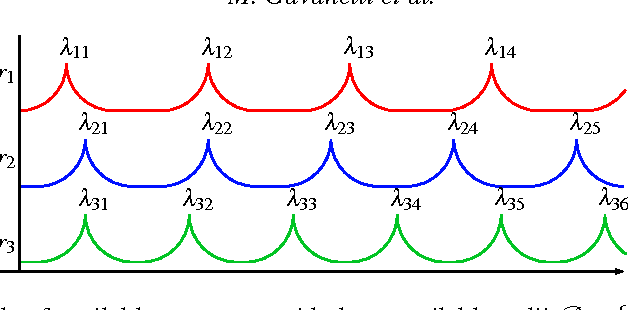

Abstract:One promising trend in digital system integration consists of boosting on-chip communication performance by means of silicon photonics, thus materializing the so-called Optical Networks-on-Chip (ONoCs). Among them, wavelength routing can be used to route a signal to destination by univocally associating a routing path to the wavelength of the optical carrier. Such wavelengths should be chosen so to minimize interferences among optical channels and to avoid routing faults. As a result, physical parameter selection of such networks requires the solution of complex constrained optimization problems. In previous work, published in the proceedings of the International Conference on Computer-Aided Design, we proposed and solved the problem of computing the maximum parallelism obtainable in the communication between any two endpoints while avoiding misrouting of optical signals. The underlying technology, only quickly mentioned in that paper, is Answer Set Programming (ASP). In this work, we detail the ASP approach we used to solve such problem. Another important design issue is to select the wavelengths of optical carriers such that they are spread across the available spectrum, in order to reduce the likelihood that, due to imperfections in the manufacturing process, unintended routing faults arise. We show how to address such problem in Constraint Logic Programming on Finite Domains (CLP(FD)). This paper is under consideration for possible publication on Theory and Practice of Logic Programming.
Multi-Criteria Optimal Planning for Energy Policies in CLP
May 15, 2014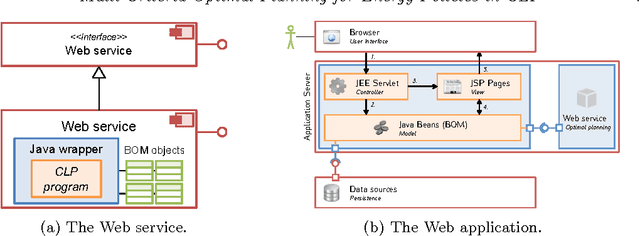
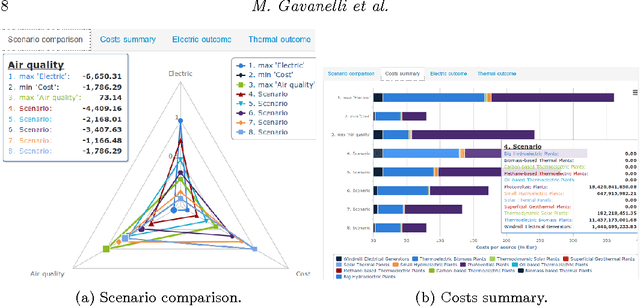
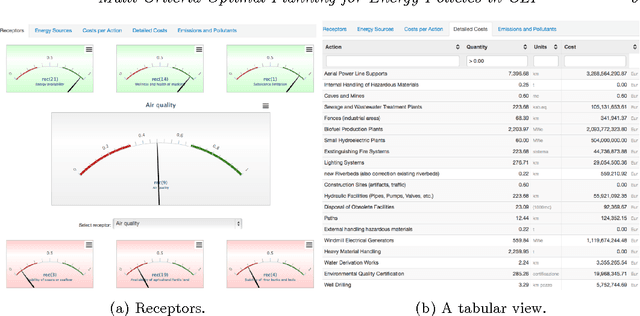
Abstract:In the policy making process a number of disparate and diverse issues such as economic development, environmental aspects, as well as the social acceptance of the policy, need to be considered. A single person might not have all the required expertises, and decision support systems featuring optimization components can help to assess policies. Leveraging on previous work on Strategic Environmental Assessment, we developed a fully-fledged system that is able to provide optimal plans with respect to a given objective, to perform multi-objective optimization and provide sets of Pareto optimal plans, and to visually compare them. Each plan is environmentally assessed and its footprint is evaluated. The heart of the system is an application developed in a popular Constraint Logic Programming system on the Reals sort. It has been equipped with a web service module that can be queried through standard interfaces, and an intuitive graphic user interface.
Logic-Based Decision Support for Strategic Environmental Assessment
Jul 19, 2010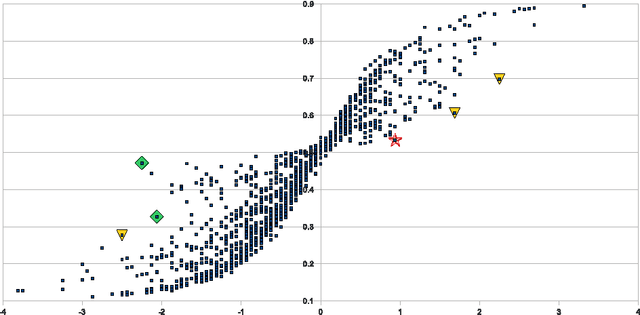
Abstract:Strategic Environmental Assessment is a procedure aimed at introducing systematic assessment of the environmental effects of plans and programs. This procedure is based on the so-called coaxial matrices that define dependencies between plan activities (infrastructures, plants, resource extractions, buildings, etc.) and positive and negative environmental impacts, and dependencies between these impacts and environmental receptors. Up to now, this procedure is manually implemented by environmental experts for checking the environmental effects of a given plan or program, but it is never applied during the plan/program construction. A decision support system, based on a clear logic semantics, would be an invaluable tool not only in assessing a single, already defined plan, but also during the planning process in order to produce an optimized, environmentally assessed plan and to study possible alternative scenarios. We propose two logic-based approaches to the problem, one based on Constraint Logic Programming and one on Probabilistic Logic Programming that could be, in the future, conveniently merged to exploit the advantages of both. We test the proposed approaches on a real energy plan and we discuss their limitations and advantages.
* 17 pages, 1 figure, 26th Int'l. Conference on Logic Programming (ICLP'10)
A CHR-based Implementation of Known Arc-Consistency
Aug 24, 2004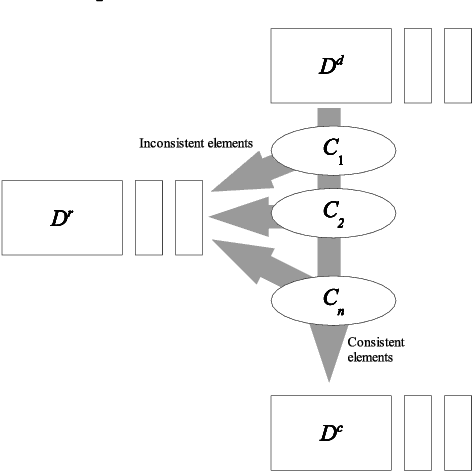
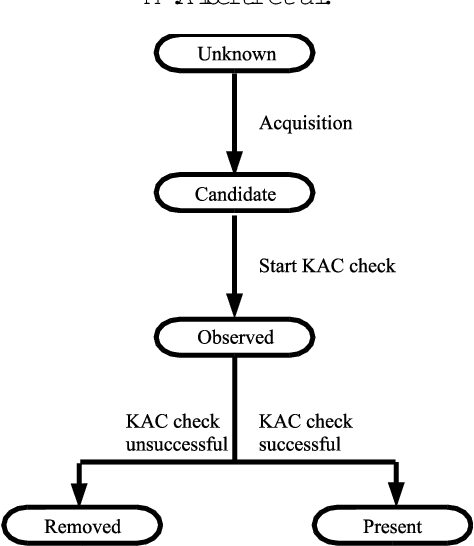
Abstract:In classical CLP(FD) systems, domains of variables are completely known at the beginning of the constraint propagation process. However, in systems interacting with an external environment, acquiring the whole domains of variables before the beginning of constraint propagation may cause waste of computation time, or even obsolescence of the acquired data at the time of use. For such cases, the Interactive Constraint Satisfaction Problem (ICSP) model has been proposed as an extension of the CSP model, to make it possible to start constraint propagation even when domains are not fully known, performing acquisition of domain elements only when necessary, and without the need for restarting the propagation after every acquisition. In this paper, we show how a solver for the two sorted CLP language, defined in previous work, to express ICSPs, has been implemented in the Constraint Handling Rules (CHR) language, a declarative language particularly suitable for high level implementation of constraint solvers.
 Add to Chrome
Add to Chrome Add to Firefox
Add to Firefox Add to Edge
Add to Edge